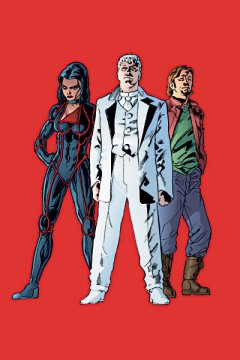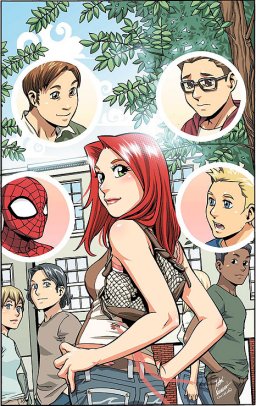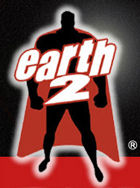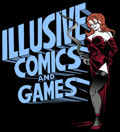|
Jason
Schachat's Occasional Breakdown
10/31/06, page 2
page
1 page
3
Planetary
#26, the penultimate issue of the long-running
long-delayed Warren Ellis/John Cassaday project, wraps up
the entire conflict of the series so quickly, it damn near
defies summarization.
Here goes.
Elijah Snow tells
Jakita Wagner and The Drummer he wants the listening device
they ripped out of John Stone fixed up so he can use it
to contact the remaining members of The Four. That done,
he proposes to Randall Dowling that he simply hand over
to Planetary all the scientific knowledge they’ve
been keeping to themselves for the last half century.
All the cures
to disease. All the pollution-free power sources. All the
data on the inner-workings of the universe. All the useless
toys the Japanese haven’t patented yet.
Why should Dowling
fork it over? Because Snow mocks him, then agrees to meet
him in person, unarmed and alone.
Granted,
it’s not the strongest motivation Ellis has ever typed
up, but there’s a logic to it. More importantly, he
avoids the pitfall Mark Millar happily walks into on every
Ultimates climax: what do you do when the heroes
and villains are finally revealed to each other and square
off? Millar cuts the battle up into tiny pieces and drags
it out, but Ellis, as he did in The Authority,
has his heroes say “screw it” and not only remove
the threat but the source of the threat, as well.
Of course, it
might’ve been hard for the Ultimates to take out the
Skrull homeworld or... every non-Americanized government
on the Earth... but you get the point.
While
other Warren Ellis books have paddled into different waters
and explored different themes, Planetary remains
cast in the same mold as his breathtaking run on The
Authority. Larger in scope than the arcs in that book
and Global Frequency, Planetary has paid off more
slowly, testing us with issues that seemed wholly unrelated
to the story. And then it’d all come together.
Of course,
Planetary also has the luxury of being seen through
rose-tinted lenses. It HAS to remind us of the Authority
days. That’s when the damn story was started.
So maybe
the great feat is that it still makes sense. Even after
the long wait, the climax works. Cassaday’s art is
still enthralling. The characters are consistent. If only
we could’ve said the same for Rising Stars,
eh?
However, we still
have another issue left before we can break out the champagne.
Longtime readers, keep it on ice a little longer. Newbies,
time to catch up.
Spider-Man
Loves Mary Jane #11 plays a nice counterpoint
to the problems I pointed out in last week’s review
of Amazing Spider-Girl. The pacing, plotting, and
subject matter are perfect for manga readers who go for
teen drama. The art has a more Japanese flavor to it without
being totally derivative. The story is told by dialogue
and layout rather than endless boxes of narration.
But
then something else struck me: there are no adults in this
comic. Zip, zero, zilch. The prior volumes (Mary Jane
and Mary Jane: Homecoming) would occasionally show
us a teacher or coach or something, but I can only think
of two adult characters that have appeared in this run (the
school counselor and the drama teacher).
And that’s
what makes this book great.
Instead
of introducing us to a football coach and making us have
to worry about his drinking problem that started after he
shot a kid on a camping trip; instead of focusing on MJ’s
parents and how they might need “me” time; instead
of wasting precious pages on a news reporter trying to track
down Spider-Man; instead of endless subplots about adults,
Sean McKeever makes this book ALL ABOUT TEENAGERS.
When Mary Jane
rises to even higher heights of popularity thanks to her
lead role in the school play, we don’t worry about
what her parents think. No, the story plunges headlong into
how the limelight can change even the meekest of girls into
a hyperactive social butterfly. Flash Thompson and Liz Allen,
still tender from their on-again-off-again romantic wounds,
are the first to notice the shift.
Then we find
that Harry Osborn has himself swung from being an incurable
shyguy to the school’s resident playa’. But,
even though he manages to go through two girlfriends at
one party, Harry still can’t stand to see Mary Jane
getting near other boys. When MJ pleasantly brushes him
off at a party, he too starts to realize that something’s
changed in her.
What none of
them realize is it has nothing to do with her popularity.
Again, this book
draws a lot of its strength from the focus on teenagers
in a teenage world with teenage problems. Unlike so many
books which try to morph adult concerns into a high school
setting, this one captures all the selfishness and self-hate
that goes with puberty.
Takeshi Miyzawa’s
art is a perfect match to McKeever’s pacing, playing
off all the manga-style cues and avoiding the bizarre pandering
that brought down all the Marvel “Manga” titles.
The character designs are pretty enough to catch the eyes
of younger readers, yet have the depth and consistency needed
to keep old comic fans coming back.
Best
of all, he never goes through the Jailbait Syndrome so many
artists suffer. When Mary Jane gets dressed up for a party,
she looks like a pretty high school girl would. Not strutting
around in a skintight cocktail dress with a mile of cleavage.
Unlike, say, Ultimate Spider-Man, which clearly
gears itself towards a male audience, Spider-Man Loves
Mary Jane has the kind of character designs comics
need to bring women and children back into Spidey-Mania
full time. Pick this book up, and grab one for a friend
while you’re at it.
Page
3: Superman/Batman Annual #1, Ultimate Spider-Man #101...
|







